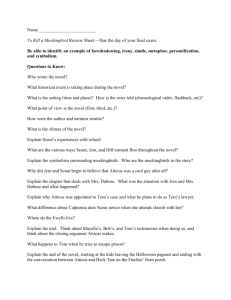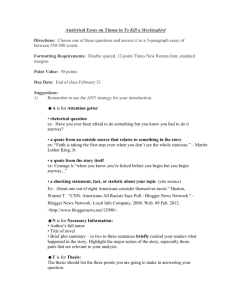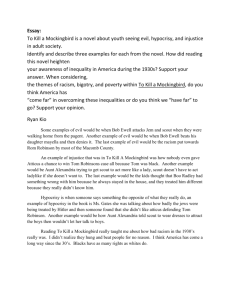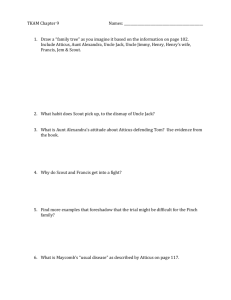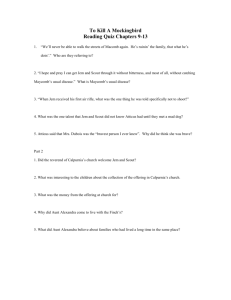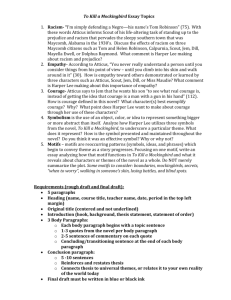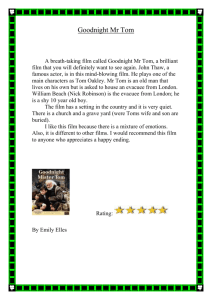To Kill a Mockingbird
advertisement
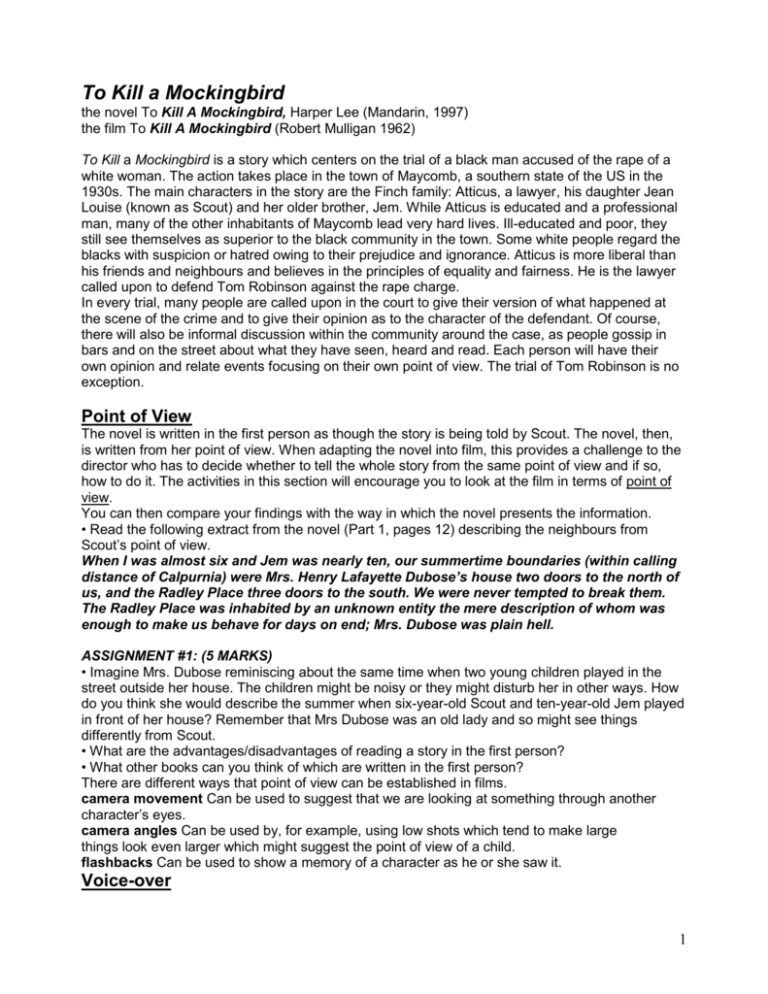
To Kill a Mockingbird the novel To Kill A Mockingbird, Harper Lee (Mandarin, 1997) the film To Kill A Mockingbird (Robert Mulligan 1962) To Kill a Mockingbird is a story which centers on the trial of a black man accused of the rape of a white woman. The action takes place in the town of Maycomb, a southern state of the US in the 1930s. The main characters in the story are the Finch family: Atticus, a lawyer, his daughter Jean Louise (known as Scout) and her older brother, Jem. While Atticus is educated and a professional man, many of the other inhabitants of Maycomb lead very hard lives. Ill-educated and poor, they still see themselves as superior to the black community in the town. Some white people regard the blacks with suspicion or hatred owing to their prejudice and ignorance. Atticus is more liberal than his friends and neighbours and believes in the principles of equality and fairness. He is the lawyer called upon to defend Tom Robinson against the rape charge. In every trial, many people are called upon in the court to give their version of what happened at the scene of the crime and to give their opinion as to the character of the defendant. Of course, there will also be informal discussion within the community around the case, as people gossip in bars and on the street about what they have seen, heard and read. Each person will have their own opinion and relate events focusing on their own point of view. The trial of Tom Robinson is no exception. Point of View The novel is written in the first person as though the story is being told by Scout. The novel, then, is written from her point of view. When adapting the novel into film, this provides a challenge to the director who has to decide whether to tell the whole story from the same point of view and if so, how to do it. The activities in this section will encourage you to look at the film in terms of point of view. You can then compare your findings with the way in which the novel presents the information. • Read the following extract from the novel (Part 1, pages 12) describing the neighbours from Scout’s point of view. When I was almost six and Jem was nearly ten, our summertime boundaries (within calling distance of Calpurnia) were Mrs. Henry Lafayette Dubose’s house two doors to the north of us, and the Radley Place three doors to the south. We were never tempted to break them. The Radley Place was inhabited by an unknown entity the mere description of whom was enough to make us behave for days on end; Mrs. Dubose was plain hell. ASSIGNMENT #1: (5 MARKS) • Imagine Mrs. Dubose reminiscing about the same time when two young children played in the street outside her house. The children might be noisy or they might disturb her in other ways. How do you think she would describe the summer when six-year-old Scout and ten-year-old Jem played in front of her house? Remember that Mrs Dubose was an old lady and so might see things differently from Scout. • What are the advantages/disadvantages of reading a story in the first person? • What other books can you think of which are written in the first person? There are different ways that point of view can be established in films. camera movement Can be used to suggest that we are looking at something through another character’s eyes. camera angles Can be used by, for example, using low shots which tend to make large things look even larger which might suggest the point of view of a child. flashbacks Can be used to show a memory of a character as he or she saw it. Voice-over 1 In this method, the actor speaking is off-screen and the audience can only hear his or her voice, while we look at a set of images on-screen. The opening of the film To Kill a Mockingbird uses this technique. • Compare the opening of the novel (below) with that of the film. Although the two openings are different, they both do the same job of informing us who is telling the story: A woman is saying these words but we cannot see her. Instead we are looking at Maycomb, the town she is telling us about. This voice is, in fact, that of Scout, many years later. Novel “When he was nearly thirteen my brother Jem got his arm badly broken at the elbow.” Film “Maycomb was a tired old town even in 1932 when I first knew it. Somehow it was hotter then.” ASSIGNMENT #2 (10 MARKS) Imagine there has been an incident in the canteen this lunchtime involving you and someone else. You are both called to the principal’s office to give your version of events. You then relay the story of what happened to your friend as you’re walking home later that day. How might the two versions differ? What factors will influence the content and style of the conversations? The woman whose voice we hear at the beginning of the film is talking about events that happened a long time ago in her past. How might this influence the way in which she tells her story? Extension • Now look at page 11 in the novel. This is the part of the novel that the filmmaker based the voiceover which begins the film. Think about the differences in the two versions. What information is left out or added and why? LIGHTING ”Lighting can be hard, soft, or any gradation in between. Hard lighting creates strong shadows, while soft lighting is shadowless. The type of lighting depends on the type of story to be told. Lighting can be manipulated to achieve a desired dramatic 2 effect…..Depending on its context, lighting can signify truth and wisdom……Dark or harshly lit pictures can trigger feelings of fear, tension and a sense of impending evil in the audience.” 1 "Lighting creates atmosphere. A mixture of dark shadows and pools of light may create a sense of unease, as in a thriller; if the lighting makes everything bright, the atmosphere may seem more relaxed. The filmmaker can use lighting to draw our attention to, or hide, a person or object." 2 "Soft lighting and a low level of color contrast (many gray tones) help give many of the shots in To Kill A Mockingbird (1963) a soft, romantic, nostalgic feeling." 3 "A Look At Boo" Consider this scene in regards to lighting. - what time of day is portrayed in the scene? - where (from what direction) does the lighting emanate? - what might be generating this kind of light? (i.e. moonlight; streetlight) - notice how half of Jem's face is in the light, the other half in the dark - notice the shadows on the wall created by the column on the porch and by the rocking chair on which Scout is perched - notice the other shadows, for example, running along the length of the house wall, perhaps generated by trees in the distance - in what ways does the "dark or harshly lit pictures (in this scene) ….trigger feelings of fear, tension and a sense of impending evil " ? ASSIGNMENT #3 (5 MARKS) Analyze a Scene - Boo Radley's Porch. The night scene in which the children sneak up to the Radley house dramatizes their fascination with and their fear of the unknown. How do the filmmakers use lighting, music, sound effects, and camera work to heighten suspense? How suspenseful does the scene seem to viewers today? Narrating 3 Another technique for varying the point of view in film is where an actor describes something that we, the audience, cannot see. In the film To Kill a Mockingbird, this happens in the following instances: 1 Jem, Scout and Dill wait outside the courtroom to find out what Atticus is doing. We do not see Atticus or the inside of the court. All our information comes via Dill, who, standing on Jem’s shoulders, describes what he can see from his point of view, peering through a high window into the courtroom. 2 When Tom Robinson gives his testimony, he tells the court the story of how he came to know Mayella. A film could have used a flashback and a voice-over but instead, we just listen to the story and the camera focuses on the actor playing Tom Robinson. ASSIGNMENT #4 (5 MARKS) • View the two sequences from the film described above. Listen carefully to what Dill and Tom Robinson say and make notes on this. • If you were directing another version of these two sequences and decided to show what Dill and Tom tell us what would you show happening on screen? List your shots like this: Depicting the story of Dill’s description of the courtroom: Shot 1: A big close-up of a man with his eyes closed and a fly buzzing around him which makes him wake up and open his eyes as the camera draws back to take in the bench he is sitting behind. Shot 2: A long shot of the same man with the courtroom in front of him. Shot 3: A mid close~up of Atticus and Tom Robinson sitting at a desk talking seriously but inaudibly to each other at the front of the courtroom with people filling the seats behind them. ASSIGNMENT #5 (5 MARKS) In the courthouse during the trial of Tom Robinson, some of the shots are used to indicate that we are seeing things from Jem’s point of view. Some of the shots show the action occurring at a distance but in others we can see the action at very close range. • What effect do the two different types of shot have on us as an audience? • How is sound used in this scene to indicate different points of view? Impartial Point of View Some of the sequences in the film are told from an impartial point of view e.g. Atticus meeting Bob Ewell in the courthouse when he informs Bob that he will defend Tom Robinson. We do not see this sequence through Scout’s eyes. It is simply presented to the audience who judge the sequence for themselves. ASSIGNMENT #6 (5 MARKS) 4 • View this sequence from the film. How does the filmmaker ensure that the viewpoint here is impartial? In a first person novel, the narrator can only tell us about things that she sees or hears about. As a result, the novel of To Kill a Mockingbird does not tell us about the incident between Atticus and Bob Ewell because Scout was not there when it happened. Look again at the clip which shows Atticus and Bob Ewell meeting and imagine that Scout had witnessed it. Now try to write what Scout would have said about the meeting in the novel. How would she have described the way the two men looked? What might she have noticed about the way Bob Ewell spoke to her father? Would she have understood what the conversation was about? ASSIGNMENT #7 (DIARY ENTRIES = 2 X 5 =10 MARKS) Your task is to produce two written accounts from the point of view of a) Tom Robinson and b) Scout. The accounts will be diary entries made while the jury is out discussing the final verdict. Although both diary entries will be about the same events (the trial and the testimonies), they will be told from different points of view Consider the factors that will influence how Tom and Scout see the courtroom sequence differently: The age of the characters since Scout is a child and Tom is an adult. The fact that Scout might not understand the adult world whereas Tom will be very aware of his status as a black man in a racist community. The fact that the trial is to decide the fate of Tom whereas Scout is only involved insofar as her father is Tom’s lawyer. Writing Scout’s diary The film shows the court sequence mainly from an impartial point of view though sometimes we are made aware that Jem is watching events very carefully. As a result, the film does not give many clues about how Scout sees the trial. Watch the court sequence again and try to imagine how Scout is feeling. When the camera does look at Scout, examine her facial expressions and think about what information they give you. Is she confused or frightened perhaps? Make notes on the following: How much of the trial that she reports does she understand? What, apart from the trial, is she thinking about in the court? How does she feel when she senses that her father, Atticus, is nervous? How sympathetic is she to Tom and to Mayella Ewell? Writing Tom’s diary The novel does not give us any direct information about Tom Robinson’s feelings because the story is narrated by Scout. To write his diary entry, you will need to use clues that are provided by the film. Watch the courtroom sequence again and make notes on what you imagine Tom is thinking and feeling during the trial. Consider the following: Tom’s facial expressions. Tom’s body language. What he actually says - and does not say. The vocabulary he uses and the way in which he speaks. The way in which he responds to others. PARTNER ASSIGNMENT (20 MARKS) 5 Choose one of scenes in the courtroom and decide who will be the director and who will be the actor. When you have decided this, rehearse the courtroom scene. It should be memorized. The director should give advice to the actor about how to play the part - how to move, what to say, how to look and how to talk. You should then swap roles and direct the same scene differently. TOM (Pages 57-60, 62-64, 67, 74, 81) POST-VIEWING ASSIGNMENT: (15 MARKS) WRITE A ONE-PAGE REVIEW OF THE MOVIE. HERE ARE SOME QUESTIONS TO HELP. Did the movie measure up to your expectations as a viewer? What scenes engaged you most or least? Why? If you've read Harper Lee's novel, compare the movie to the book. How did viewing the movie compare to the experience of reading? Notice what the film changed or left out. Why do you think these characters and moments were altered or deleted? For example, when a lynch mob confronts Atticus before the trial, Scout's innocent interference dispels the threat of violence. Compare the scene as it occurs in Chapter 15 of the novel to the screenplay (pages 70 to 75) and the final film. What other films does To Kill a Mockingbird remind you of? How are they alike? How do they differ? Compare Scout's memories of growing up in Alabama during the 1930s to your own experiences of childhood. How does the film compare to the images of childhood represented in other movies or television programs you have seen? How do you account for the differences and similarities? – Literary Aspects: o o o o o o o Dramatic Aspects: o o o o o o o Who are the characters in the film? What is the film's setting? What are the main plot elements? From whose point of view is the story told? What is the theme of the film? What is the mood of the film? What symbols did you notice? Did the actors make you forget they were acting? How? Were costumes, make-up, and set equally important to the success of the film? In what scene was an actor's voice (pitch, volume, expression) particularly effective? Select a scene that must have been difficult to act. How did the actor make his or her body movements appropriate and convincing? Describe a scene in which facial expression was important. What feelings were developed? Were words necessary? Did the actors establish their characters more through dialogue or through movement and facial expressions? Was there anything about the acting, set, or costumes that bothered you or interfered with your watching of the film? Cinematic Aspects: o o o o o What vivid visual images did you note? What did they make you feel or think about? What sounds or music do you remember? What did they make you feel or think about? What scenes can you understand even without dialogue? Why? What scene has very effective or unusual editing? If the film uses special effects, do they add to or detract from your enjoyment of the film? http://www.filmeducation.org/secondary/StudyGuides/index.html#dday 6

